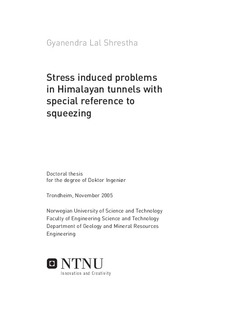| dc.description.abstract | There is a huge potential of underground constructions in the Himalayan region for hydropower, transport systems and conservation of environment. However, the tectonic activities have resulted with a fragile regional geology. Moreover, the high mountainous topography causes high overburden pressure in the underground structures causing squeezing and other stability problems. Thus the huge tunnelling potential can only be materialised by applying professional and scientific approaches.
This thesis focuses on the stress induced problems with special reference to squeezing. Main objectives of this study were to review and check validity of the available tunnel stability assessment methods, to carry out relevant laboratory tests and interpret the results, and to use a numerical modelling code. In the present study, two projects have been used as case studies, both located in Nepal Himalayan region. These are Khimti1 hydropower project - a completed project; and Melamchi water supply project - yet to be constructed. Both projects include tunnels through series of weak rock mass strata with high overburden stress.
One of the factors that may cause stability problems in a tunnel is the stress level acting around the opening. A tunnel fails when the stress exceeds the strength of rock mass. If the stress level does not exceed the rock mass strength, but is sufficient up to a critical level to cause creep, it may lead to rock failure after some time. In a tunnel stability assessment, the determination of the critical stress level is important. Creep tests were carried out on the Melamchi gneiss and the critical stress level has been determined.
The resulted creep test curves were calibrated to obtain rheological parameters. Tunnel deformations including time-effect, were calculated for a given stress level. Based on the creep test results at various uniaxial stress levels, an equation is obtained for the relation between the strain rate and stress level. Back analyses have been carried out using the available empirical, semi-analytical and analytical methods and FLAC3D code; the results have been found to be in close agreement with the tunnel convergence measurements in the Khimti tunnel. So these methods were used in the Melamchi tunnel design.
In the 66 squeezing tunnel cases from around the world and the Khimti case study, it was observed that the rock mass strength (corresponding to rock type) has a significant influence on squeezing phenomena. Thus the available squeezing prediction criteria based on the rock mass classification alone, need to be updated by including rock mass strength as well. Similarly, ‘valley side effect of topography’ has been found to influence the tunnel deformation in the Khimti project. It has opened an area for a further study to correlate the valley side effect of topography to the stress increase in the tunnel. | nb_NO |
